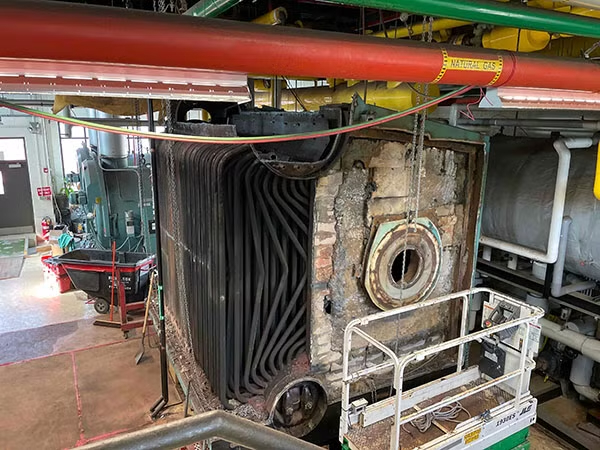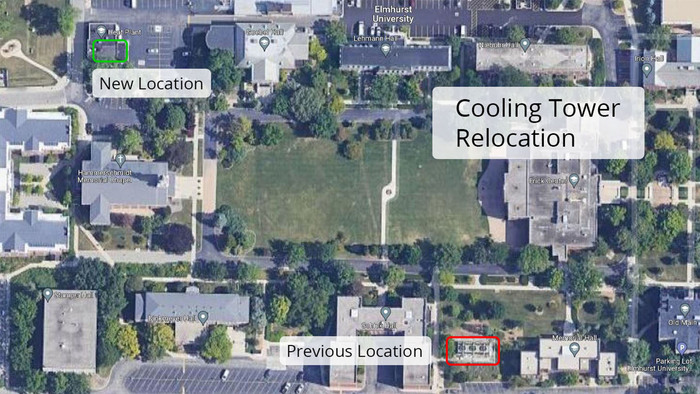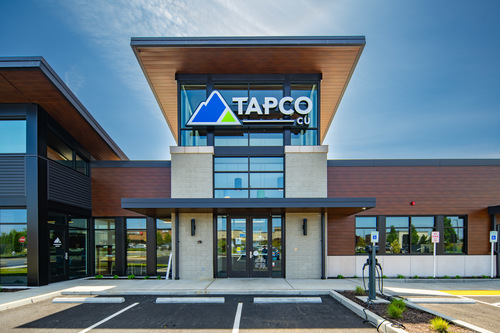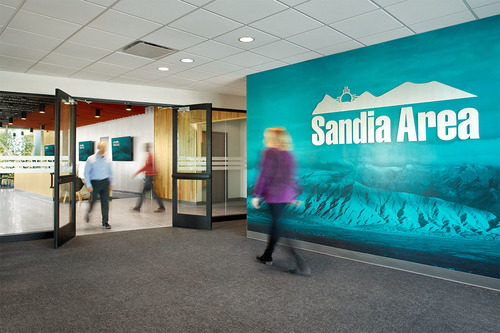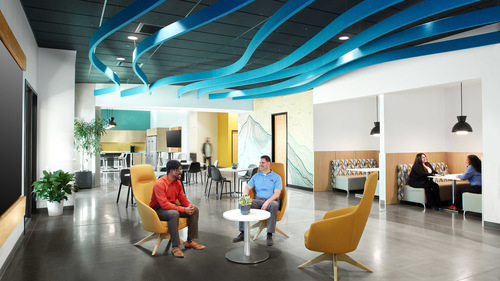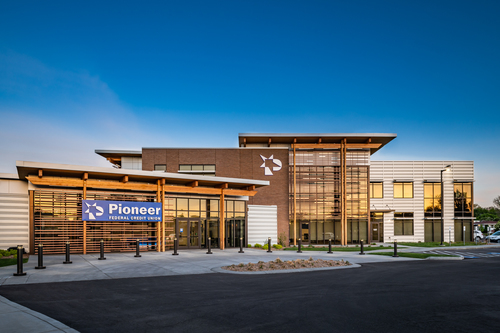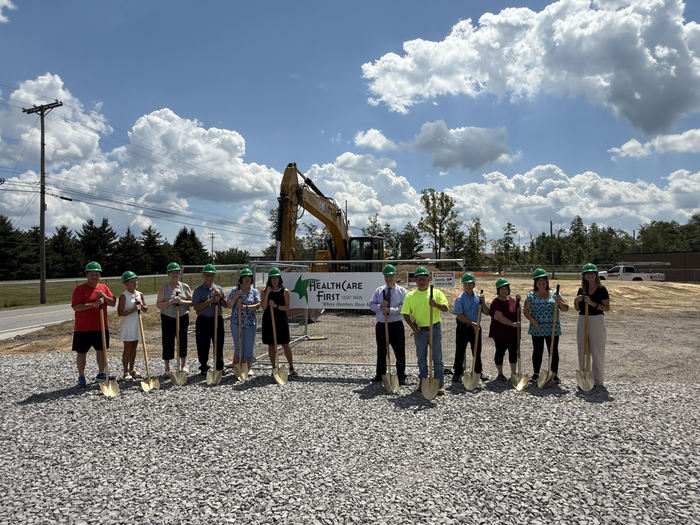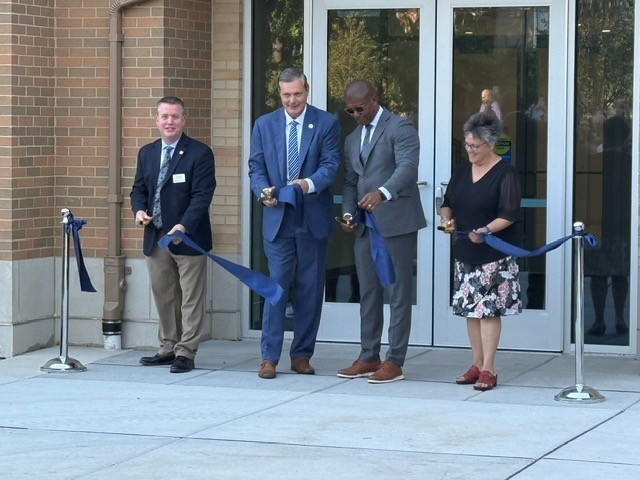Relocated Chilled Water Plant
The existing chilled water system faced similar issues as the hot water system. The chiller units required frequent operation regardless of cooling demands. The units experienced high levels of wear and tear, requiring 150% of the max running torque to start, which resulted in frequent maintenance. There was also the issue of outdated refrigerant that was due to be phased out in just a few years and would soon become very difficult and cost prohibitive to obtain.
In removing the existing steam boilers, the boiler house space became available for the placement of the three 600-ton chillers with space for a 4th chiller to address future expansion. And by moving them to this facility, we freed up space in the sciences building and eliminated the issue of vibration impacting the classrooms and labs.
AMS Mechanical Systems, an experienced Chicago area mechanical contractor with design engineering expertise, was also selected to join the team through Momentum’s competitive best value selection process.
Not only was the firm’s experience in the local labor market a key element of the selection criteria, AMS was able to fabricate a large quantity of the piping systems offsite. This minimized disruptions to an extremely active campus. Their experience in working with the local TRANE office and Riello Boiler rep was also key. TRANE was pre-selected to provide the three 600-ton chillers, pumps and digital controls, and Riello provided high efficiency 39 modular boilers.
The project delivery method was structured with AMS Mechanical serving as a prime design/build contractor to the University, with TRANE directly supplying the chillers to the University, and Momentum overseeing the entire project as the Construction Manager. This project delivery structure was used for both the pre-construction and construction phases.
Momentum applied our extensive design-build background to the project, using our unique project management process to create seamless communication and strong lines of accountability. Our adoption of digital project management platforms and processes (read more on that here) made compliance with COVID-19 restrictions a non-issue as well. Through our process, we were able to maintain clear lines of communication with all participants and complete transparency with the Elmhurst team. The same platforms that our project managers use for tracking schedule, budget, and field issues are also open to clients to monitor and audit the project in real time. We also set procedures for tradesperson access and site logistics to maximize project safety from a COVID-19 perspective and student access.
Working with Cyclone Energy, AMS Mechanical, TRANE, Riello, and the Elmhurst University team, we identified boiler decentralization and the chiller plant relocation as the most effective long-term strategy for the campus.
Decentralized Boiler System
We selected modular boilers for this project for a number of reasons. Closet-sized cabinets house multiple modular boiler units, which makes the system more efficient to operate. They are easy to install and service, parts are readily available, and maintenance costs are greatly reduced.
The small footprint of each unit means that we were able to place the units in each building, with one exception. One of the oldest buildings on campus, Irion Hall, has a particularly cramped layout, and to solve this problem we were able to place the boiler in a modified and insulated storage container adjacent to the rear of building.
The modularity of the units adds redundancy to the system as well. If there is an issue with one boiler unit, it can be pulled for maintenance or replacement while the rest of the system operates as normal. The units function independently, allowing each building to provide precisely as much hot water as needed at the time without the wasted energy of a central plant.
This decentralized system saves a tremendous amount of operating cost from lower energy usage, reduce maintenance demand, and simplified control systems.
The new Trane chillers have the same footprint as the former units, but they use variable speed drives. They run under lower stress and will be easier to maintain, and the efficiency gains both due to the more modern design and variable output results is far lower energy usage. The coolant is compliant with the Montreal Protocol for at least 40 years, ensuring that the new system will be environmentally sustainable in the long term.
The cooling towers presented another challenge. The original plan had been to relocate the cooling towers next to the former boiler house, now the chilled water plant. But this presented a problem for project stakeholders, as the area was a nice, wooded spot that was a popular break area for university staff.
Working with AMS Mechanical, we developed an innovative solution: retrofit the boiler plant roof to support more weight and place the cooling towers there. As the Elmhurst University campus is certified as an arboretum, not one tree was removed or relocated as a part of the project, a project mandate from day one.
The cooling towers previously occupied a large piece of land in a prominent area of campus, and their removal will allow the university to repurpose this land.
Contracts and Financing
Financing a project like this is a complicated process. Energy Service Companies (ESCOs) often claim to offer easy and integrated solutions to boiler and chiller system upgrades, or so it appears at first glance. This was the route that Elmhurst University started down when we were initially contacted.
We reviewed the proposed financial proforma with Cyclone Energy Systems and found that between financing costs, design and construction costs, equipment costs, and unrealized design opportunities, the university was projected to invest much more than necessary with a sub-optimal outcome projected. This analysis made clear that it made much more sense for the university to finance this project with capital rather than to seek the services of an ESCO.
Outcome
We were able to deliver this project within the projected timeframe and investment goals. The new systems solution is optimized for energy efficiency, reduces maintenance and operations costs, earned significant rebates and incentives, and helps Elmhurst University maximize the use of their campus footprint.
Our unique construction management process played a key role in this success. We enlisted the services of the commissioning agent from the very beginning, where adjustments to the project design cost much less and were much easier to implement than they would have been during the development of construction documents. We also used modern project management tools such as Smartsheet and Procore in an innovative way that ensured that every project participant and stakeholder was on the same page.
This meant that nothing fell through the cracks. The utilities conversion was a time sensitive issue, and our project managers identified new utilities connections at each building as a high risk. They proactively negotiated with the public utilities providers to highlight the critical nature of the connections, and were able to have the new gas lines installed before the heating season and the new electrical connections were made before cooling demand was a concern.
Construction projects are always a major challenge for colleges and universities, with mid-project risks often surfacing and cost and schedule overruns being the norm. Momentum’s ability to represent owners while bringing design-build and construction management best practices to these projects provides institutions with an “easy mode.” We organize and integrate project team members so that they can have the greatest positive impact, we proactively identify and manage risks, and we deploy tools that maximize transparency and accountability so that all team members can accurately track and communicate the status of a project.
